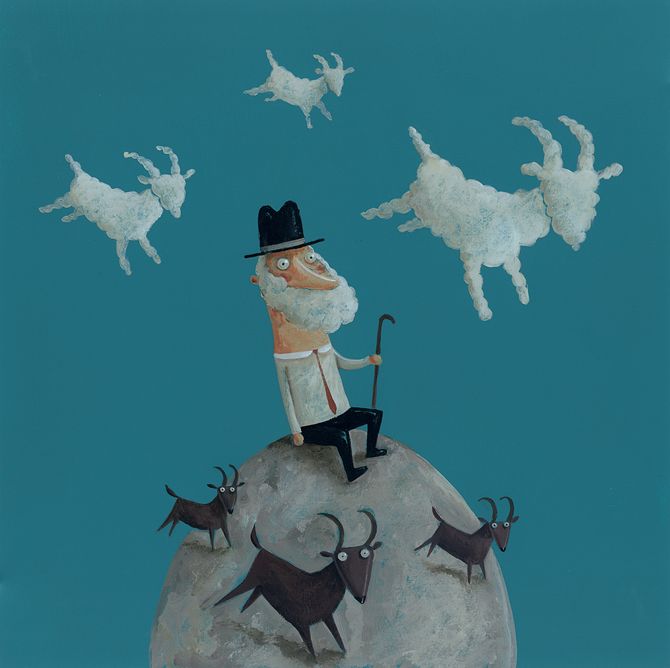Q&A: João Vaz de Carvalho
July 31, 2018

The Portuguese painter and illustrator shares his creative process and reflects on the message behind his images.
For João Vaz de Carvalho, painting has been his central artistic medium. But he is more than just a painter-he is also an illustrator-most notably recognized for his children’s book drawings. We talked to Vaz de Carvalho about the value of hand drawn images and what inspires his work.

Illustration for the book Famílias Destrambelhadas.
How did you develop your illustration style?
Painting has always been my main form of expression. The freedom this medium allows has given me the ideal space for my language to mature. In contrast to illustration, which is usually subordinated to a theme or a text, the thematic independence of painting opens up territories of almost boundless liberty, where the only limit is imagination. Figuration has always been a central feature of my painting, with characteristics very similar to those of the language of illustration. Because of this “illustrative” side, my work was noticed and my first commissions for illustration soon followed, initially for the press and later for publishers. Alongside my work as a painter, I started to work as an illustrator, and I continue to do both.

Illustration entitled 'City III.'
Can you describe your creative process?
My work starts when I read the text. After this, I take some time to reflect and mentally explore possible approaches. And it’s usually at this stage that I make my first decisions about the palette of colours I’m going to use. Then comes the crucial part of the work, the first sketches, where all my doubts surface and where I can try out various solutions. I give great importance to composition. The final collection of drawings must be consistent and convincing. The images (in the case of an illustrated book) should not only take their place in the narrative but also have their own value. Every one of them should captivate and surprise the reader. At this stage, I already have an idea as to how I’m going to paint them, but it’s only when I start to add colour that I see whether it’s going to be possible to achieve the result I’m after. There are always false starts and mistakes and I often have to paint the same thing more than once. It’s always a process that moves forward on different fronts. As far as possible, I like to keep everything open until the whole project is finished. The cover should encapsulate the contents of the book and so it is usually the last thing I do.

Illustration entitled 'Home 4.'
Who are some of your clients?
Some clients I have worked with are; Kalandraka Publishers, Vista Alegre, Livros Horizonte, Teatro de Marionetas do Porto, Londji Creative Toys, L’atelier du Poisson Soluble and Editora Tcharan.

Illustration entitled 'No Jardim #25.'
Your style is bright and has a real handmade quality to it. Why do you think this resonates with your clients?
As I am essentially a painter, it’s natural that my work has the characteristics of something done by hand. I think this is a method that will gradually become more valued in the future because there are fewer and fewer illustrators who work this way – most prefer to work digitally. But I also think that what matters most is the content of images rather than the technical process used to create them. At the end of the day, I think that clients value creativity above all else. The tools we use are always just accessories to the process.

Illustration entitled 'O Mergulhador.'
Where do you get your creative inspiration?
Inspiration can come from places we least expect, but I feel that my memories and experiences inspire me the most. Many vivid, but distant memories insist on appearing and reappearing in my work. I had a happy childhood and this repeatedly invades my work. I’m interested in objects with a story, they fascinate me, especially old toys. That being said, anything or any situation that is unexpected can spark my interest and influence my work.
What message or mood do you hope your illustrations convey?
Perhaps one of the most obvious aspects of my work is a healthy sense of humour. That being said, I think that what is communicated isn’t just the humour. This is difficult to express in words, but I feel that there is more, less apparent, content which challenges the observer and invites more serious interpretations.

Illustration for the book Uma Vida de Papel.
What equipment or tools do you use?
Pencils, paintbrushes, acrylics, canvas and paper.
What projects are you currently working on? Anything big you would want to tell our readers about?
I have just finished illustrating a book for a South Korean publisher. I have also started work on illustrations for two other books; one for a French publisher and another for a Portuguese publisher. I have also embarked on a completely new challenge for me, two animated films. One will be developed with a Brazilian producer, Osso Filmes, and the other is being produced by one of the most important Portuguese producers of animated film, Animanostra.

Illustration for the storytelling festival Passa a Palavra.

Illustration for the book Famílias Destrambelhadas.

Illustration for the book Famílias Destrambelhadas.







